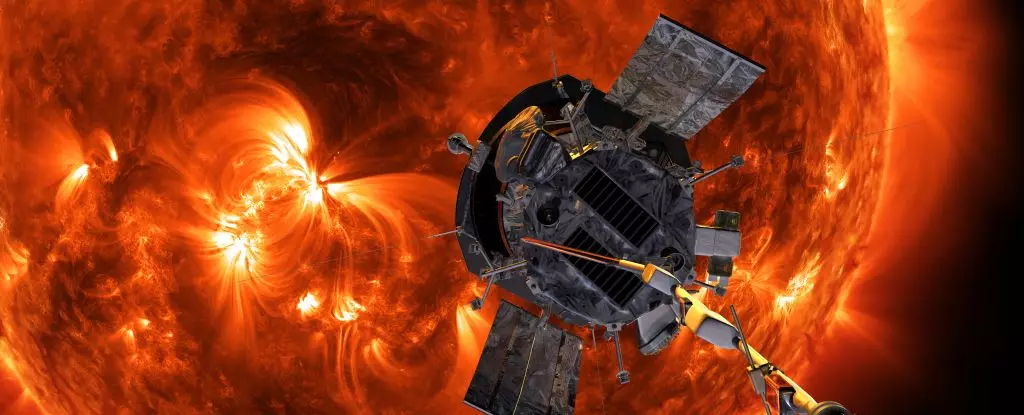NASA’s Parker Solar Probe is poised to achieve a groundbreaking feat in the ongoing quest to unravel the mysteries of our closest star, the Sun. On December 24th, 2023, the spacecraft is set to make its 22nd close flyby, bringing it within a staggering 6.1 million kilometers (3.8 million miles) of the Sun’s surface. This journey, taking place at a speed of approximately 192 kilometers per second, will mark the closest any human-made object has ever ventured toward the Sun, cementing Parker’s status as a pioneer in solar research.
The probe, which launched in 2018, has consistently pushed the boundaries of solar proximity records, delivering invaluable data that challenges our understanding of solar physics. As the Parker Solar Probe embarks on this significant mission, it does so against the backdrop of our ongoing quest to comprehend the complex dynamics of the Sun. As physicist Arik Posner aptly notes, this mission exemplifies NASA’s role in embarking on audacious endeavors that tackle age-old questions about our universe.
One of the most profound conundrums surrounding the Sun lies in the mystery of its atmosphere—the corona. Surprisingly, this vast layer of plasma, which extends some 8.3 million kilometers into space, is much hotter than the Sun’s surface, or photosphere. The Parker Solar Probe aims to explore this phenomenon by gathering data that could shed light on the mechanisms responsible for this unexpected temperature disparity.
Furthermore, the probe seeks to address questions surrounding the Sun’s magnetic field and its cyclical patterns of activity. The solar magnetic field’s origins are still poorly understood, as are the forces driving solar cycles. By swooping into the corona to take direct measurements, the Parker Solar Probe intends to illuminate these shadows in our knowledge and provide insight into the underlying processes that govern solar dynamics.
Through its series of perihelion approaches, starting with the December flyby, the probe promises to transform our grasp of solar behavior, bridging the gaps in our comprehension that have persisted for centuries.
As the Parker Solar Probe prepares for its upcoming flyby, the anticipated event not only symbolizes the ambition of human ingenuity but also presents a series of logistical challenges. The mission is essentially a high-stakes endeavor, as Parker must navigate a delicate balance between performance and survivability in the hostile environment close to the Sun. This proximity to extreme temperatures and solar radiation poses significant risks to the spacecraft’s systems.
Anticipation within the scientific community is palpable, as performance footage and communications from the Parker will unveil whether the craft can withstand these adversities. The successful completion of the December 24 flyby will be followed by a crucial transmission to confirm the probe’s condition, setting the stage for future maneuvers and data gathering.
Parker’s mission is expected to conclude with at least four additional perihelion flybys through 2025. As the probe reaches the limits of its fuel reserves, its operational capabilities will dwindle, leading to its fiery demise in a blaze of glory, quite literally. Astrophysicist Justin Kasper has illustrated the end of the probe’s journey vividly, suggesting that the spacecraft will become a molten remnant on a vast solar trajectory—an enduring testament to human exploration.
Throughout its operational life, Parker Solar Probe has already redefined our approach to solar science, setting the stage for future missions and hypothesis-driven research. The data collected will not only provide insights into our solar system’s star but could also innervate research into distant stars and exoplanetary systems, enriching our comprehension of stellar evolution across the universe.
As the Parker Solar Probe embarks on its upcoming missions, we stand at the precipice of a new era in solar science. The forthcoming data from its December flyby and subsequent approaches will likely yield groundbreaking revelations about our Sun’s complex nature. Scientists eagerly await the unfolding narrative that Parker will bring, a story that promises not just answers, but also new questions about our solar system and beyond.
NASA’s Parker Solar Probe represents human ambition and innovation. As it fearlessly delves into the Sun’s corona, it showcases the enduring quest for knowledge that defines our species. Just as the Apollo missions united humanity in the exploration of the Moon, the Parker Solar Probe may soon lead us to newfound understanding, unearthing the Sun’s secrets and imparting wisdom that could influence scientific inquiry for generations to come.


Leave a Reply